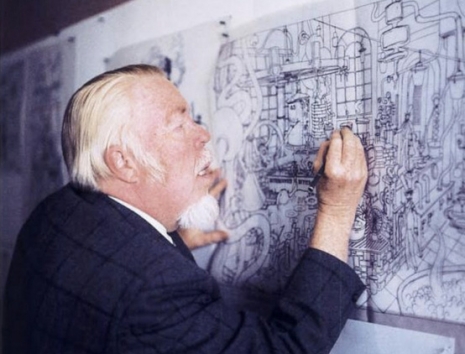
“This is where all my dreams become realities, and some of my realities become dreams.” American artist and banjo player Harper Goff (1911-1993) was a man of many talents with an extraordinary imagination. He set the standard for camouflage colors during WWII, laid the foundation for the Steampunk revolution, conceptualized Disneyland alongside Walt Disney, and created the unforgettable set for Willy Wonka’s chocolate factory. However, due to issues with his union card Harper remains uncredited for nearly his entire life’s work.
Living in New York City, Harper Goff worked as a magazine illustrator for Collier’s, Esquire, and National Geographic. Harper’s techniques as well his imagination were groundbreaking even early on. In his paintings, he often refused to use modeling talent but instead incorporated real life village citizens into the details of his colorful works. Friends, family, and neighbors traveled to exotic beachfront estates and vacation spots around the world courtesy of Harper Goff, half of them never even realizing it. During his service in WWII while Harper was working on a do-it-yourself painters kit he was approached by the U.S. Army to develop a set of paint colors that would become the new standard for camouflage. Near the end of the war, he was transferred to the U.S. Navy where his razzle dazzle technique helped confuse the silhouettes of ships taking the idea of camouflage to a whole new level.
When Harper moved to California to work for Warner Brothers Studios he became a set designer on films such as Casablanca, Sergeant York, Charge of the Light Brigade, A Midsummer Night’s Dream, and the Errol Flynn classic Captain Blood. It was while working as an Art Director on Kirk Douglas’ The Vikings that director William Wyler saw in Goff a “character type” and began casting him as an actor. “I showed up wearing a beard, they figured I’d make a good Nordic,” said Harper, who would end up heaving a battle axe at his blonde viking wife in the film. Harper made dozens of appearances in film and television as an actor much to the amusement of his real life blonde wife Flossie. In 1951, while shopping in a London model railroad shoppe Harper had a chance encounter with Walt Disney when they both expressed a mutual interest in purchasing the same model train.
“He turned to me and said, ‘I’m Walt Disney. Are you the man that wanted to buy this engine?’ Well, I almost fell over. He asked me what I do for a living, and I told him that I was an artist. Walt said, ‘I’ve heard of you, but I can’t recall where.’” It turned out Walt Disney had seen some of Harper’s illustrations in Esquire magazine and had always admired them. Disney said, “Give me a call me when you get back to the States.” Ultimately Walt bought the locomotive and hired Harper to illustrate the earliest concept artwork and renderings for his proposed “Mickey Mouse Park” (originally intended to be constructed in Burbank). “I liked the idea of working with Walt Disney, and when I called him he began to explain his idea for a kiddie-land near the Studio — perhaps with a steam train connected to Traveland across the L.A. River. He wanted to build something adults could enjoy along with their children.”
Walt sent Harper on a three-month “information gathering” journey to amusement parks all across the United States. “They were dirty places and it was hard to imagine what Walt had in mind creating. I said to him when I got back, ‘Walt, I don’t think this type of environment is what you want,’ and he replied, ‘Mine will be immaculate and the staff will be young and polite,’ then I realized he could do it.” Orange County was eventually chosen as the site for Disneyland and Harper, who was dubbed the “Second Imagineer” envisioned the look and feel of the theme park. Harper used his hometown of Fort Collins, Colorado as the main influence for Disneyland’s City Hall, and his Art Director experience on the film Calamity Jane to design the Golden Horseshoe Saloon.
Harper Goff’s influence on the Adventureland portion of the theme park cannot be overstated, particularly on the ride the Jungle Cruise. In Harper’s own words: “We began to think of hippos and other animals which could be operated without wires and still have animated elements. We brought in Bob Matte, who later created the shark for Jaws to engineer the original animals. I also worked with Bill and Jack Evans on buying expeditions for the landscaping. We would call cities to see if they were tearing out trees for improvements and go and buy them — we got many that way.” While making trips back and forth between Burbank and the Evans and Reeves Nursery in West L.A. they’d pass a house in Beverly Hills that had spectacular tree in the front yard. Harper and Jack believed it’d be the perfect finishing touch to the Jungle Cruise ride. “Finally, I thought what have we got to lose, and I had Jack Evans stop while I went in to ask the people if they would consider selling it. I told the owner we would replace it with a flowerbed or anything they wanted and surprisingly enough the owner told me yes — it was blocking the sunlight and view coming through his windows and we could just come and take it away… it was the tree that went around the original Burmese Temple, and we got it for nothing.”
Continues after the jump…





